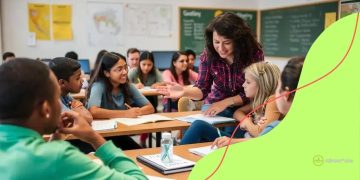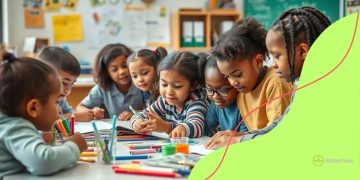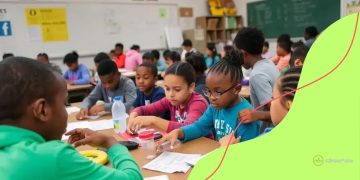Fostering creativity and innovation in the classroom
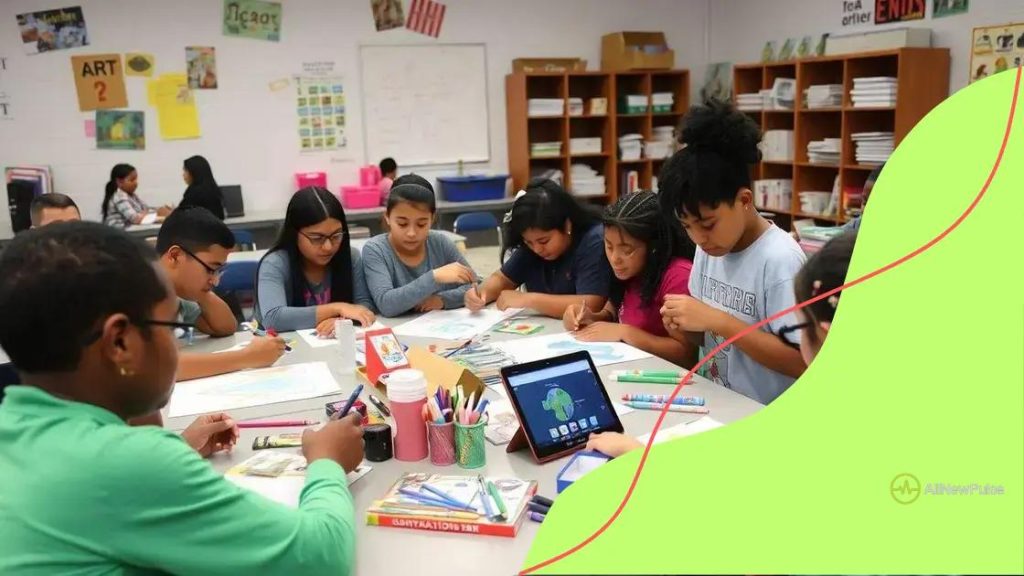
Fostering creativity and innovation in the classroom involves promoting collaboration, integrating technology, and providing constructive feedback, which collectively enhance student engagement and encourage innovative thinking.
Fostering creativity and innovation in the classroom is essential for engaging students and building a stimulating learning environment. Have you ever considered how much more motivated learners can be when they can express their creative thoughts?
The importance of fostering creativity
Understanding the importance of fostering creativity is essential for nurturing a vibrant learning environment. When students are encouraged to think creatively, they develop problem-solving skills that are crucial in today’s world. Creativity isn’t just about art; it’s about innovative thinking and expressing ideas in unique ways.
Enhancing Student Engagement
Creative activities engage students on a deeper level. When they use their imagination, learning becomes more enjoyable and meaningful. This involvement can lead to:
- Increased motivation to participate
- A stronger connection to the subject matter
- Improved retention of information
Moreover, fostering an environment that encourages creativity can help students feel more confident. They learn to take risks and not fear failure. This confidence can empower them to share their ideas openly and collaborate with their peers.
Developing Critical Thinking
Creativity plays a significant role in developing critical thinking skills. Through creative exercises, students learn to analyze problems, generate solutions, and evaluate outcomes. They start to see multiple perspectives and understand that there may be more than one right answer. This kind of thinking can be beneficial beyond the classroom, preparing them for future challenges.
By integrating creative tasks into everyday lessons, teachers can cultivate an atmosphere where students are more likely to express themselves. For instance, incorporating storytelling, role-play, or brainstorming sessions can transform standard lessons into interactive experiences.
Fostering creativity also encourages collaboration. Working together on creative projects allows students to share their unique ideas and learn from one another. This teamwork not only enhances their social skills but also prepares them for real-world situations where collaboration is often necessary.
Encouraging Lifelong Learning
Finally, when students experience the joy of creativity, they are more likely to develop a love for learning that lasts a lifetime. They begin to see learning as an exciting adventure rather than a chore. This mindset can instill a sense of curiosity, motivating them to explore a wide range of topics and experiences beyond the classroom.
Techniques to encourage innovative thinking
Implementing techniques to encourage innovative thinking in the classroom can transform how students approach learning. When educators use specific strategies, they create an environment where creativity thrives and new ideas can flourish.
Using Open-Ended Questions
One effective technique is to pose open-ended questions. These prompts allow students to explore their thoughts without the pressure of right or wrong answers. Questions like “What would happen if…?” or “How might we improve this idea?” encourage deeper thinking.
- Fosters critical and creative thinking.
- Invites multiple perspectives and solutions.
- Helps students articulate their ideas confidently.
By nurturing a habit of inquiry, students become more engaged and willing to share their thoughts.
Encouraging Collaboration
Collaboration is another key technique. Group work provides students with the opportunity to brainstorm together, leading to innovative solutions. When students collaborate, they learn to respect different viewpoints and build on one another’s ideas. This teamwork can be enhanced through:
- Group projects that require collective problem-solving.
- Peer review sessions for feedback on their work.
- Creative workshops focused on a shared goal.
This collaborative approach not only boosts creativity but also develops essential social skills.
Additionally, integrating real-world problems into classroom discussions can spark innovative thinking. When students tackle relevant issues, they become more invested in finding solutions. These real scenarios make learning more relevant and engaging, compelling students to think outside the box.
Incorporating Technology
Utilizing technology is also a creative catalyst. Tools like digital art platforms, coding apps, or virtual reality can enhance the learning experience. When students interact with technology, they often find new ways to express their ideas. This exposure can lead to:
- Enhanced creativity through interactive learning.
- Opportunities to experiment without fear of failure.
- Access to tools that help visualize complex concepts.
Ultimately, these techniques can create a dynamic classroom atmosphere where innovative thinking is the norm. By implementing these strategies, educators can cultivate a love for learning that propels students toward success in their academic journeys.
Integrating technology into creative lessons
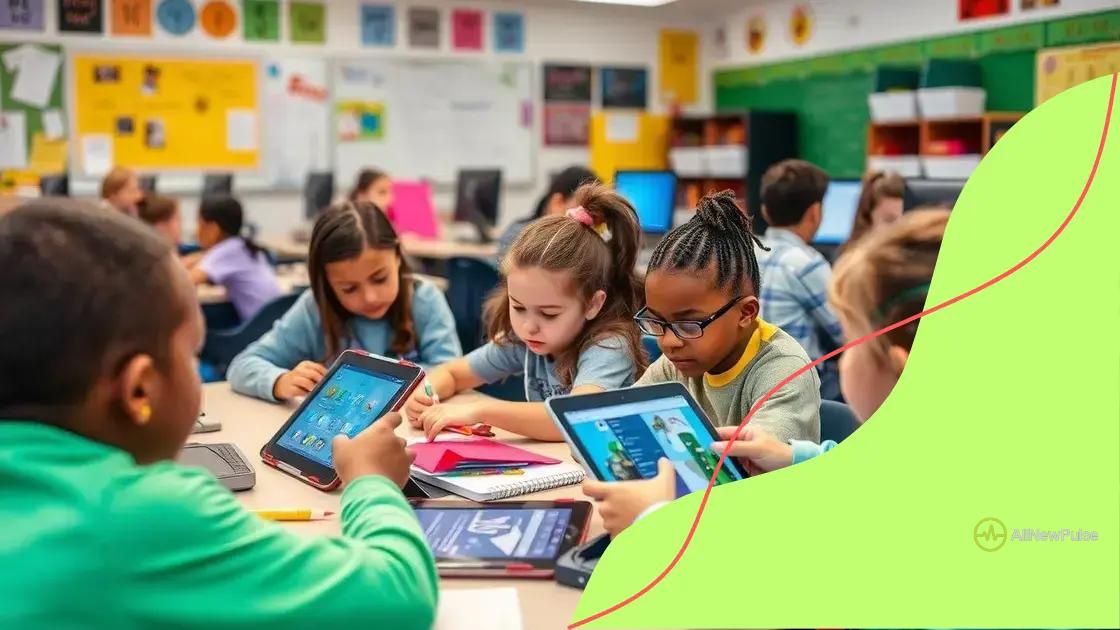
Integrating technology into creative lessons is a powerful way to enhance student engagement and foster innovation. When technology is seamlessly woven into the curriculum, it opens up new avenues for creativity and expression. This approach allows students to explore subjects in dynamic ways.
Embracing Digital Tools
Digital tools can transform traditional lessons into interactive experiences. Programs like Google Workspace, educational apps, or multimedia presentations enable students to present their ideas creatively. For example, using digital storytelling apps can help students narrate their stories using images, videos, and sound.
- Encourages collaboration among peers.
- Enhances visual learning experiences.
- Provides instant feedback on assignments.
By embracing these tools, teachers can make lessons more engaging and relevant to students’ lives.
Utilizing Online Resources
Online resources also play a crucial role. Websites like virtual museums, educational YouTube channels, or interactive simulation platforms can bring subjects to life. When students can see real-world applications, they are more likely to understand and remember the material. Integrating resources like these can:
- Awaken curiosity about various topics.
- Encourage independent research.
- Make learning more accessible for diverse learners.
This variety enriches the learning experience and enhances knowledge retention.
Incorporating technology does not mean replacing hands-on activities. Instead, it can enhance them. For instance, students can use tablets to document their creative processes or create interactive presentations showcasing their projects. This blend of traditional and modern approaches supports a comprehensive learning experience.
Encouraging Multimedia Projects
Multimedia projects offer another effective way to integrate technology. Students can combine text, images, audio, and video to articulate their understanding of subjects. This method not only showcases their knowledge but also encourages them to think creatively about how they present information. Students may create:
- Video tutorials on a specific topic.
- Podcasts discussing their favorite subjects.
- Interactive infographics that illustrate key points.
Such projects empower students to express themselves in unique ways while developing essential skills for the future.
Collaborative projects that inspire creativity
Collaborative projects that inspire creativity are essential in modern education. When students work together, they share their unique perspectives and ideas. This not only sparks creativity but also fosters teamwork skills that are vital in the real world.
Benefits of Collaborative Work
Engaging in collaborative projects provides numerous benefits. Firstly, students learn to communicate effectively with their peers. This communication helps them practice articulating their thoughts clearly. Secondly, working in teams can lead to a sense of community and belonging. Students feel more empowered when they support one another.
- Encourages diverse viewpoints.
- Builds problem-solving skills.
- Strengthens social relationships among students.
Furthermore, collaborative projects often result in more innovative solutions. When students brainstorm together, they can build on each other’s ideas, leading to unexpected and exciting outcomes.
Examples of Collaborative Projects
There are countless examples of projects that promote cooperation and creativity. For instance, creating a class mural or sculpture can allow students to express their individual styles while contributing to a larger artwork. Another idea is designing a community garden, where each student can submit a plant they wish to grow. This collaborative effort teaches responsibility and provides practical learning experiences.
- Class presentations on shared topics.
- Science experiments that require teamwork.
- Storytelling sessions where students write a story together.
Additionally, technology can enhance these collaborative projects. Students can utilize platforms like Google Docs or Trello to organize their work, communicate in real-time, and track project progress. This not only streamlines their collaboration but also prepares them for tech-savvy environments in the future.
Encouraging collaboration through projects prepares students for successful careers. By learning to work with others and embrace creativity, they develop important skills that will serve them well beyond the classroom.
Assessing creativity in student work
Assessing creativity in student work is crucial for understanding how well students can express their ideas and think outside the box. It’s essential to have clear criteria that focus on different aspects of creativity. This assessment can help educators provide constructive feedback and encourage further creative development.
Criteria for Assessment
Effective assessment should consider multiple dimensions of creativity. Some key criteria include originality, effort, and the implementation of ideas. When assessing, consider the following:
- Originality: Is the work unique? Does it offer fresh perspectives or ideas?
- Effort: Did the student take the time to develop their thoughts and skills?
- Implementation: How well did the student execute their ideas? Is the final product polished?
This multi-faceted approach to assessment helps students see where they excel and where they can grow.
Providing Constructive Feedback
After assessing the work, it’s essential to provide feedback that encourages improvement. Constructive feedback should focus on strengths while also highlighting areas for enhancement. Suggestions could include:
- Encouraging them to take more risks in their ideas.
- Suggesting new techniques or tools they might use.
- Pointing out how collaboration could enhance their creativity.
When students receive this type of feedback, they are more likely to feel motivated to explore their creativity further.
Incorporating self-assessment can also be beneficial. When students evaluate their work, they develop critical thinking skills and become more aware of their creative processes. They can reflect on questions like: What did I do well? What could I do differently next time? This reflection fosters a growth mindset, encouraging them to embrace challenges.
Using Rubrics for Clarity
Utilizing rubrics can help clarify expectations for creativity assessments. A well-structured rubric outlines specific criteria and levels of performance. This gives students a better understanding of how their work will be evaluated. A clear rubric can guide them as they create, helping them focus on the important aspects of their project.
In summary, assessing creativity is not just about judging the final product. It’s about understanding the creative process and providing support for students’ journeys. By focusing on various aspects of creativity and incorporating effective feedback, teachers can nurture a creative culture in the classroom.
FAQ – Questions about fostering creativity in the classroom
How can collaboration enhance student creativity?
Collaboration allows students to share diverse ideas and perspectives, leading to more innovative solutions and approaches.
What role does technology play in creative lessons?
Technology provides interactive tools that engage students and enhance their ability to express ideas creatively.
Why is constructive feedback important in creative work?
Constructive feedback helps students understand their strengths and areas for improvement, motivating them to develop their creative skills further.
What criteria should be used for assessing creativity?
Assessment criteria can include originality, effort, and the implementation of ideas, ensuring a comprehensive evaluation of student work.



